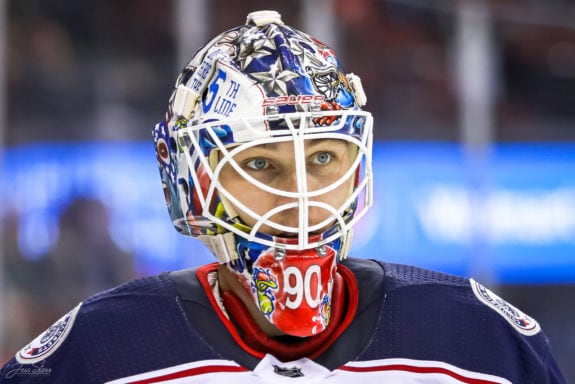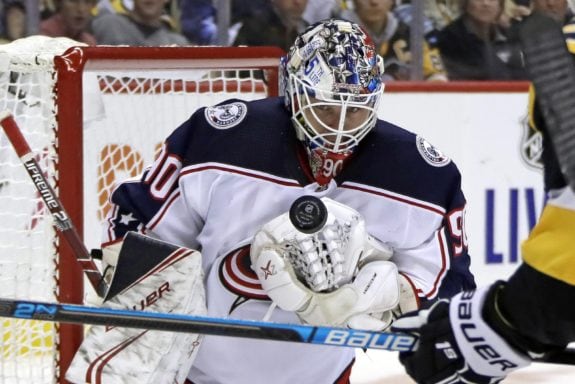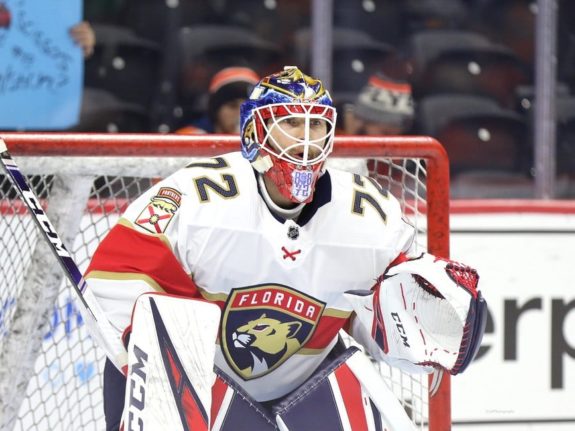The Columbus Blue Jackets absolutely had to re-sign goalie Elvis Merzlikins. So, successfully getting their potential starter under contract is great news. However, just like how every cloud has a silver lining, the opposite can be true. It is here as well.
Blue Jackets Set in Net?
Undeniably, the Blue Jackets are in a luxurious position from a goaltending standpoint for next season. In addition to having just signed Merzlikins to a two-year, $8 million deal, they also inked Joonas Korpisalo to a two-year, $5.6 million extension.

So, they’re actually in great shape until 2022. After all, Korpisalo earned an All-Star Game selection this past season and Merzlikins enjoyed a stellar campaign, during which he effectively stole the No. 1 spot from the former.
However, what happens past that point? Both Merzlikins and Korpisalo are set to be unrestricted free agents once their respective deals expire.
To their credit, yes, the Blue Jackets have transformed into a goalie factory. Twenty-three-year-old Matiss Kivlenieks proved he has NHL potential with the few starts he got this past season. Joining him on the depth chart are Veini Vehvilainen and Daniil Tarasov, who’s the youngest of the bunch at 21 years old and may have the most upside.
So, the prospect pipeline is fully intact. Logic still states a bird in the hand is better than two in the bush. In this specific case, it’s more like two birds in the hand are better than four, as Peter Thome, a 23-year-old prospect coming off an impressive season at the University of North Dakota, rounds out the team’s goaltending depth chart.
Merzlikins Becomes the Man to Beat
Regardless of the potential of each of their goaltending prospects, there are a lot of question marks. In comparison, the Blue Jackets have a pretty decent idea of what they have in both Merzlikins and Korpisalo at this stage.

To illustrate the point, Kivlenieks far from embarrassed himself when he got called up last season. He went 1-1-2, even getting a victory in his first-ever start by stopping 31 of 32 shots. However, his overall save percentage in six games played ended up a disappointing .898. So, no one should get carried away yet. It would be a mistake to pencil him for an NHL job even in two years’ time, when he’ll already be 26 years old.
Granted, the situation is somewhat similar to last summer, when the Blue Jackets faced a lot of uncertainty with Sergei Bobrovsky departing for the Florida Panthers. However, it was different in the sense that the Blue Jackets made the best of a bad situation. They had no choice but to place their trust in Korpisalo, who had earned an .897 save percentage as Bobrovsky’s backup in each of the previous two seasons, and Merzlikins.
Merzlikins vs. Korpisalo
Admittedly, Merzlikins had been earning rave reviews as having NHL potential while playing overseas in the National League in Switzerland. However, until he arrived and started playing, no one knew for sure.
Hell, no one really knew up until Korpisalo got injured right before New Year’s Eve and Merzlikins got thrust into the starter’s role. Up until that point, he had struggled mightily, going 0-4-3 in nine appearances with an .889 save percentage. Practically everyone knows the rest of the story: Up until Korpisalo returned, Merzlikins dominated, going 12-5-4 with a .935 save percentage.
In fact, Merzlikins ranks in the top 10 in overall goals-against average (2.35), save percentage (.923) and shutouts (five), even taking into account his early-season struggles. As a result, you have to believe Blue Jackets’ general manager Jarmo Kekalainen got a bargain re-signing him only for $4 million per season. Combined, the two goalies have a cap hit of $6.8 million.
To put that figure in perspective, the starting goalies of five separate teams have higher cap hits all alone. That includes Bobrovsky, so clearly the Blue Jackets had a decent offseason last summer, even if they had to let him go. They more than replaced him at a veritable fraction of the cost.
Merzlikins vs. Bobrovsky
Maybe that was the trade-off. Maybe Kekalainen could only get Merzlikins and Korpisalo to re-sign for as relatively little as they did as long as they could test free agency two seasons from now. However, you would have thought the Blue Jackets would have had more leverage than that.
Consider Korpisalo’s lack of consistency and Merzlikins’ short track record and the fact that both had been restricted free agents. That the Blue Jackets couldn’t parlay what was a position of strength into longer-term deals, specifically with Merzlikins, should be seen for what it is: a huge disappointment.
The Blue Jackets can only hope to convince Merzlikins to stay by taking the franchise to new heights in the playoffs in each of the next two seasons. It all goes back to Bobrovsky, like it or not, as the Blue Jackets had just won their first playoff series in franchise history only to see him leave for greener pastures.

Thankfully, Merzlikins is not Bobrovsky. He’s a half-decade younger and just entering his prime instead of exiting it. Furthermore, Merzlikins is also a completely different person. He can think for himself and is far from constrained by the theory that history repeats itself. However, Kekalainen and the Blue Jackets must learn from the past too. Extending Merzlikins was only half of the battle. Re-signing him is the other half. It’s far from completely clear skies ahead. Now the real work begins.